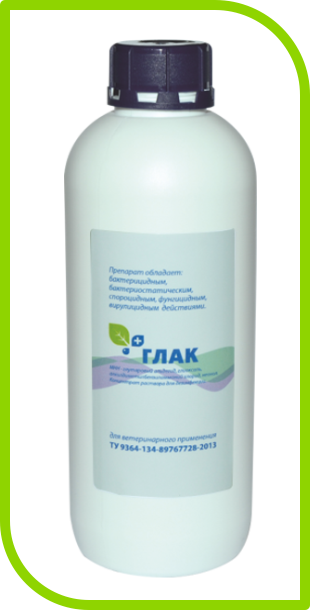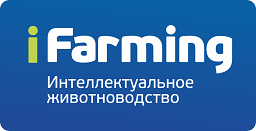
INSTRUCTIONS
of using GLAK for disinfection
(Organization-developer: “BioKhimPharm”, Raduzhny, Vladimir region).
I. General information
1. Trade name of the preparation: GLAC.
International non-proprietary name: glutaraldehyde, glyoxal, alkyl dimethylbenzylammonium chloride, neon.
2. Form of preparation: concentrate solution for disinfection.
The preparation as active ingredients in 100 g contains 4 g of glutaraldehyde, 3.2 g of glyoxal, 10 g of alkyl dimethylbenzylammonium chloride and a filler.
3. The GLAK is produced in 1, 3, 5 and 10 liters packed in cans of polymer material. Shelf life of the drug under the conditions of storage in closed packaging – 3 years from the date of manufacture.
It is forbidden to use GLAK at the expiry date.
4. The drug is stored in a sealed manufacturer’s packaging at a temperature of minus 10 ° C to 40 ° C away from heating devices.
5. The GLAK should be stored in places inaccessible to children.
6. Special precautions for disposal of unused product and expired shelf life are not required.
II. Pharmacological properties
7. The drug has a bactericidal and bacteriostatic (gram-positive and gram-negative bacteria), sporicidal, fungicidal, virucidal action regardless of humidity and ambient temperature. It dissolves well in water in any proportions. The activity does not decrease with increasing water hardness and in the presence of organic substances.
Glutaraldehyde, which is a part of the preparation, has a wide spectrum of antimicrobial activity (bactericidal, fungicidal, virucidal, sporicidal).
Glioksal also belongs to the class of aldehydes and in combination with glutaraldehyde mutually reinforce antimicrobial action.
Catamin (benzalkonium chloride) relates to cationic surfactants and is a quaternary ammonium salt – a mixture of alkyldimethylbenzylammonium chloride wherein alkyl – alkyl radicals mixture of normal C10-C18 or C12-C14. It has antimicrobial activity, which increases the disinfecting effect of the drug.
Included in the composition of the GLAK nonionic surface-active substances of neon improves the wettability of surfaces with the working solutions of the preparation and has a bacteriostatic effect, which increases the effectiveness of the preparation.
A preparation according to the degree of impact on the body is a moderately dangerous compounds (hazard class 3 according to GOST 12.1.007-76): LD50 for mice when administered into the stomach of 1215 mg / kg. Working solutions do not have a locally irritating, allergenic and cumulative effect. Do not cause corrosion of metals, do not corrode the fabric, the surface of wood and polymer materials. Residual amounts of the drug remain active for up to a week.
III. The order of application
8. GLAK is used in the form of an aqueous working solution for preventive and forced disinfection:
– livestock, poultry, fur farming premises, technological equipment in them, auxiliary livestock and animal care equipment;
– production facilities and technological equipment at the enterprises of meat, poultry industry and plants for the processing of products of slaughter premises sanitary slaughterhouses and meat processing plants at slaughterhouses, dairy units at dairy farms and complexes, kormokuhon, as well as containers for storage of feed and animal products origin;
– motor vehicles, railway wagons and other types of vehicles (used for transportation of animals, raw materials and products of animal origin), as well as open objects (ramps, platforms, platforms), places of animal clustering (territory and objects of pre-slaughter maintenance, markets, sports grounds, etc.);
– premises, equipment and equipment in zoos, circuses, nurseries, vivariums, veterinary clinics and clinics;
– overalls of attendants;
– disinfection of eggs and treatment of premises in the presence of animals.
9. Contraindication to use is the individual hypersensitivity of animals to the components of the drug.
10. Disinfection is carried out by means of small-drop irrigation, immersion, wiping or volumetric aerosols.
Work solutions are prepared by adding the appropriate amounts of GLA to tap water. When calculating the concentration of working solutions, the agent is taken as 100% substance (Table 1).
Table 1
|
Concentration of working solution (%) |
Amount per 100 liters of working solution |
|
|
GLAK, l |
Water, l |
|
|
0,5 |
0,5 |
99,5 |
|
1 |
1 |
99 |
|
2 |
2 |
98 |
|
4 |
4 |
96 |
|
5 |
5 |
95 |
11. Preventive disinfection of the surfaces of livestock (poultry, fur farming) premises and technological equipment in the absence of animals, as well as other vetnadzor facilities, is carried out with a 0.5% solution of GLAK at a rate of 0.3 l / m² and an exposure of 3 hours.
Preventive disinfection of vehicles, railway cars and other vehicles used to transport animals, meat, meat products and raw materials of animal origin is carried out with a 0.5% solution at a rate of 1 l / m² at an exposure of 3 hours.
12. Forced (current and final) disinfection of surfaces for infectious diseases of bacterial and viral etiology, whose causative agents are classified as low-resistant (1st group) and resistant (group 2) in resistance to disinfectants, 1% solution is administered at a rate of flow in both cases 0.5 l / m², with an exposure of 3 hours.
The forced (current and final) disinfection of the surfaces of premises with infectious diseases caused by pathogens belonging to the highly resistant (3rd group) tuberculosis of animals and birds is carried out with a 2% working solution at a rate of 1 l / m² and an exposure of 3 hours.
Forced disinfection of the surfaces of premises with infectious diseases caused by pathogens related to particularly resistant (group 4) – spore infections, is carried out with a 4% solution when applied twice at intervals of 1 hour at a rate of 0.5 l / m² at each irrigation and exposure after the second treatment at 3 o’clock.
With trichophytosis of cattle and aspergillosis of birds, a 4% solution of GLAC is used at the rate of 1 l / m² of the area with an exposure of 3 hours.
13. For disinfection of wagons in the second and third category, apply a 5% solution of the drug at a rate of 1.25 l / m² area with an exposure of 3 hours.14. After the established exposure to disinfection, feeding troughs, drinking bowls and other areas of surfaces accessible to animals, places of direct contact with raw materials, products of animal origin, places of possible accumulation of residues of disinfectant are washed with water. It is not required to remove residual GLA from the other surfaces. Animals are introduced into the premises after ventilation (open windows, doors, hatches, turn on ventilation) for 3 hours.
14. The processing of motor vehicles, wheels, railway cars is carried out with 4% solution at 2-fold application at a rate of 0.25 l / m² at each irrigation with an interval of 15 minutes. After treatment, vehicles are kept on the sludge site for at least 30 minutes.
Overalls with contamination pathogens, except for the 4 groups of resistance, are decontaminated by soaking in 1% solution in closable containers, in a ratio of 4 liters of solution per 1 kg of dry overalls, with an exposure of 24 hours. At the end of the exposition, the overalls are rinsed well in water, followed by washing in the usual manner.
Dezbarriers and disinfectants fill 4% with a GLAK, which is changed daily.
15. Treatment of premises in the presence of animals in order to reduce the microbial and viral load (when contaminated with pathogens related to 1 and 2 resistance groups):
– when processing by the method of small-drop irrigation, the application rate of the drug is 0.2-0.4 liters of 0.5% solution per 1 m2;
– When treating voluminous aerosols with the help of TAN, RCC, SAG-1, etc., 50% solution of the drug is used – 2 cm³ per 1 m³. Exposure time is from 2 to 5 minutes.
16. Disinfection of eggs:
– When processing eggs with fine drip irrigation, the drug consumption rate is 1 liter 0.5% solution of the preparation for every 75 m² of the surface.
Quality control of disinfection is carried out in accordance with the methodology set out in the “Rules for disinfection and disinfection of objects of state veterinary supervision” (2002).
IV. Personal prevention measures
17. When working with the drug, you should follow the general rules of personal hygiene and safety, provided for when working with medications. The treatment should be carried out in dressing gowns, rubber gloves, sealed goggles, and to protect the respiratory organs use a respirator of the type RU-60M or RNU-67 with a gas cartridge of grade A.
18. Do not drink, smoke or eat while working with the GLAK. After working with the drug, wash your hands with soap and water.
19. After contact with eyes and mucous membranes, floss should be washed with plenty of tap water.
20. In case of disinfection of the premises of vetsanexpertise laboratories in the markets after the exposition, all processed objects are thoroughly washed with water, the premises are ventilated and dried.
21. Do not use the drug in the presence of food in the room. Entering the treated room is allowed an hour after ventilation.





